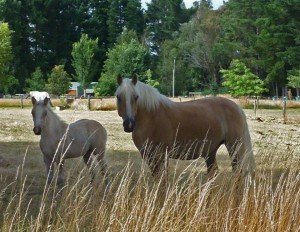Breed Standards
(a) Type
 A body structure that is suitable for an all-round pleasure horse is desirable. A harmonious distribution of forehand, mid-section and hindquarters is ideal. The desired appearance is that of an elegant and harmonious horse. A (lean and expressive) head with large eyes a well-formed neck, a sufficiently coupled and supple mid-section, a good croup, not too divided and not too short, defined limbs with good joints. Stallions and mares for breeding should have clearly defined masculine or feminine features.
A body structure that is suitable for an all-round pleasure horse is desirable. A harmonious distribution of forehand, mid-section and hindquarters is ideal. The desired appearance is that of an elegant and harmonious horse. A (lean and expressive) head with large eyes a well-formed neck, a sufficiently coupled and supple mid-section, a good croup, not too divided and not too short, defined limbs with good joints. Stallions and mares for breeding should have clearly defined masculine or feminine features.
Colours from light chestnut to dark liver chestnut with white/blonde mane and tail. Colour impurities in the body base colour, as in roaning dark smudges, or white markings larger that a tennis ball are undesirable and will be judged as negative up to the point of exclusion.
Head markings are desirable, but not a prerequisite, too many markings are undesirable and can go as far as causing exclusion. White leg markings are not desirable, white leg markings above the hock or knee will result in exclusion. A creamy frosting in the area of the lower cannon and fetlocksis normal for the breed
The required size is from 135 cm. Mares must be 135 centimetres plus and stallions must be 140+ centimeters. The minimum size must be achieved, non-achievement leads to exclusion.
(b) Head
 The head should be noble and lean, the size in harmony with the horse broad between the eyes and between the branches of the jaw. The eyes should be large, the nostrils set at the end of the nose rather than underneath. The head should be well set on the neck and with correct positioning of the ears which should point forwards and be appropriately sized. Some horses have a slightly dished face.
The head should be noble and lean, the size in harmony with the horse broad between the eyes and between the branches of the jaw. The eyes should be large, the nostrils set at the end of the nose rather than underneath. The head should be well set on the neck and with correct positioning of the ears which should point forwards and be appropriately sized. Some horses have a slightly dished face.
(c) Neck
The neck should be of medium length and more refined towards the head, with neither a bulky line nor a swan neck. It should not be too wide vertically nor too thick laterally. The neck should be clearly defined at the throat.
(d) Forehand
A defined wither reaching well back, long sloping shoulders and sufficient depth of girth are desirable. Proportionately wide between the front legs, with well sprung ribs and lung capacity.
(e) Midsection
The back should be medium length with loins well muscled, thereby creating good load bearing capacity. Too long in the back is regarded as a weakness.
(f) Hindquarters
The hindquarters should be long and slightly sloping with a not too strongly divided croup. The tail should not be set too low. The gaskins should be well defined and hocks let down. Ideally there should be an equilateral triangle from point of hip to point of buttock to stifle.
(g) Forelegs
The forelegs must be perpendicular to the ground and body, with clearly defined joints, flat bone and tendons running parallel to the bone. Knees should be shield shaped. The pasterns should be of moderate length (long pasterns are weak), they should slope at between 45 and 50 degrees, but must importantly they must match the angle of the shoulder and the hoof. The foreleg to cannon ration should be 2/3 forearm, 1/3 cannon, i.e. long forearm and short cannon is highly desirable.
(h) Hind legs
Hind legs must be perpendicular to the ground and body with clearly defined joints, flat bone and tendons running parallel to the bone. The hock should be clearly defined and let down, a straight line should be able to be drawn from the point of buttock through the hock to the ground bisecting the leg equally in half, hind leg angle of 150 degrees (as per classification diagram in Appendix 1 of Regulations)
(i) Feet
Hooves should be round, distinct and hard with clean open heels
(j) Correct gait
The horse’s gait whether free in the paddock, being led or under saddle, should be ground covering, free and forward moving. The rhythm should be pure, even and regular. Correct footfalls for each pace are mandatory. Knee and hock flexion is desirable with the general gait not too flat.
(k) Temperament
The horse must show a calm, quiet and intelligent disposition.
